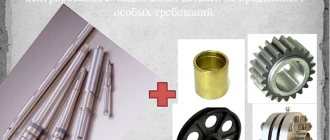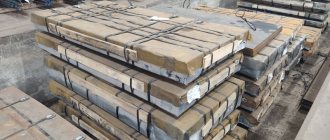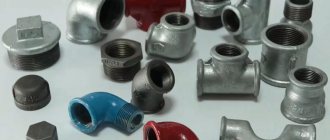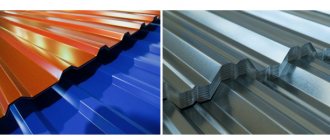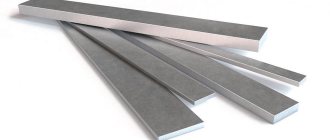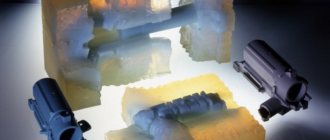To obtain any steel - an alloy of iron and carbon (Fe + C), it is necessary to achieve a certain percentage of these chemical elements. Steel will be an alloy where the proportion of carbon does not exceed 2.14%, since with a larger amount the substance will correspond to the parameters of cast iron. Thus, steel is produced, including by remelting cast iron, i.e. reducing its carbon content. It is worth noting that the latter is not responsible for the strength of the metal, but for its hardness.
Carbon steels are distinguished according to the content of element C:
- low carbon – no more than 0.25%
- medium carbon – from 0.25% to 0.6%
- high carbon – from 0.6%—2.0%
The grade 30 steel we are considering contains 0.30% carbon, which means it is a medium-carbon structural alloy.
Technological properties
Steel 30KhGSA (GOST defines the range of some properties) can be used to create various products and structures. When choosing this metal you should consider:
- Corrosion resistance is low. Prolonged exposure to high humidity may cause corrosion on the surface. This quality should be taken into account when choosing alloy steel. In some cases, corrosion resistance is increased by applying a galvanic coating to the surface, which consists of zinc and chromium. To obtain such a surface, the electrolysis method is used. However, the created surface layer is characterized by low resistance to mechanical stress - after damage, corrosion will immediately appear.
- High ductility, since the relative elongation is 11%. It also significantly expands the scope of metal application, since many parts must withstand variable loads.
- The material is characterized by high resistance to variable loads. The endurance limit of the test may vary depending on the ambient temperature.
- The Rockwell hardness rating is 50 units.
- Mechanical properties do not change at temperatures up to 400 degrees Celsius. Operation at higher temperatures is not allowed, as this will increase ductility and reduce surface hardness.
- Steel 30KhGSA, which is heat treated to increase hardness and reduce brittleness, is characterized by ductility. That is why it can be used for forging or stamping.
- Excellent elasticity allows for cutting workpieces. This is why workpieces are supplied for countersinking, milling or turning.
Mechanical properties
Annealing is often performed to improve productivity. The considered grade of medium-alloy steel belongs to the second group in terms of weldability. That is why it is recommended to preheat the structure, which reduces the likelihood of structural cracks forming. To ensure the most favorable conditions, workpieces are often heated to a temperature of 250 degrees Celsius.
Heat treatment
To improve the technical and operational parameters of finished products, heat treatment of the alloy is performed. Thanks to this, the hardness and strength of the material increases. For steel grade 30KhGSA, the following thermal treatment schemes are used. Hardening is used to change the characteristics of the surface layer. Annealing is carried out at a heating mode of up to 880 degrees, subsequent tempering is carried out in oil. This minimizes the risk of structural and surface deformations.
Any hardening involves rearrangement of the microcrystalline lattice. During processing, internal stresses often appear; in the future, they can cause the appearance of structural cracks. To prevent undesirable consequences, tempering is performed at a temperature of 540 degrees. Forging helps improve the quality of metal. Before processing begins, the workpiece is heated to 1240 degrees. Cooling is carried out in an aquatic environment or in the open air, depending on the dimensions of the product.
Analogs
The most well-known imported analogues of the 30KhGSA alloy are:
- 30HGSA, 30HGS (Poland);
- 30ChGSA (Bulgaria);
- 14331 (Czech Republic).
Their structure, chemical composition and basic operational characteristics have many similarities. However, these foreign alloys are not identical to ours. Therefore, the decision on their interchangeability must be made individually, taking into account the specific technological requirements for the finished product.
Substitutes for the alloy among Russian steels are considered to be metals of the 40KhFA, 35KhM, 40KhN, 25KhGSA, 35KhGSA grades.
Industrial use
Steel 30KhGSA belongs to high-quality alloys, always in demand in a variety of areas of production. Housings, solid pipes of various diameters, engine parts, fasteners, and weapon barrels are cast from the 30KhGSA alloy.
- In construction. High-strength fastening elements for building structures that are resistant to variable loads are produced from 30KhGSA steel. Fasteners made from 30KhGSA steel have a limited scope of application due to low corrosion resistance or require protective measures.
- In mechanical engineering and aircraft manufacturing. Solid housings, welded structures, moving parts (blades, shafts, levers, axles), and fasteners are made from 30KhGSA steel. In aircraft manufacturing, consumable parts are mainly made from 30KhGSA steel.
- In the oil and gas industry. Hot-rolled steel pipes are used as load-bearing structures for high-pressure gas pipelines.
- In the defense industry. 30KhGSA is a common weapon steel; barrels for domestic small arms are made from it.
Chemical composition
The chemical composition of 30KhGSA steel and the percentages of significant elements are given in the following table.
| Chemical element | % |
| Carbon (C) | 0.28-0.34 |
| Silicon (Si) | 0.90-1.20 |
| Copper (Cu), no more | 0.30 |
| Manganese (Mn) | 0.80-1.10 |
| Nickel (Ni), no more | 0.30 |
| Phosphorus (P), no more | 0.025 |
| Chromium (Cr) | 0.80-1.10 |
| Sulfur (S), no more | 0.025 |
According to GOST 4543-2016, the mass fraction of nitrogen cannot exceed the following indicators:
- for open hearth steel; 0.005%;
- for oxygen-converter steel without after-furnace treatment; 0.006% (thin sheets, strip) and 0.008% (other types of metal products);
- for oxygen-converter steel with out-of-furnace treatment; 0.010% (thin sheets, strip) and 0.012% (other types of metal products);
- for steel smelted in electric furnaces; 0.012%.
Circumstances under which the mass fraction of nitrogen in the alloy is not regulated or standardized:
- the mass fraction of aluminum in the alloy is at least 0.020% (for general) or 0.015% (for acid-soluble);
- Nitrogen-binding elements are present in any combination (titanium, vanadium, niobium) if the total mass fraction of elements including aluminum does not exceed 0.015%
Permissible limits for the content of residual elements (up to):
- tungsten; 0.20%;
- molybdenum; 0.11%;
- vanadium; 0.05%;
- titanium; 0.03%.
Advantages and disadvantages
Like any steel grade, 30KhGSA has a set of features that determine its scope of application. It has both strengths and vulnerabilities that limit its use in certain environments. In some cases, deficiencies can be leveled out with the help of additional processing; thermal, chemical or applying a protective coating to the surface of the product.
Advantages:
- impact strength; high ability of steel to withstand dynamic loads;
- hardness; due to the high carbon content in steel;
- wear resistance; resistance to variable loads, especially valuable quality of 30KhGSA steel, which made it indispensable in aircraft construction;
- good weldability;
- high resistance to constant thermal influence (up to 400C).
Flaws:
- Low hardenability; small depth of changes during hardening;
- Flock sensitivity; susceptibility to the formation of internal cracks, reducing mechanical performance;
- Corrosive susceptibility; steel should not be used in conditions of high humidity or direct contact with water without galvanic coating or other protective measures.
Application
The above characteristics make it possible to use the alloy in various industrial sectors:
- In construction, it is used to make fasteners that are subject to alternating bends.
- Even modern aircraft manufacturers use the alloy as a material for the manufacture of consumables: flanges, shafts and others.
- In mechanical engineering, high-quality products are produced that operate under constant variable loads.
The cost depends on the quality and dimensions of the scrap, as well as on the planned supply volumes.
Mechanical characteristics
Grade 30KhGSA differs from conventional structural steels in its increased strength and resistance to impact loads. The yield strength is 820 MPa. For comparison, stainless steel 12Х18Н10Т “flows” already at 400 MPa. Complete destruction of steel occurs at a load of 980 MPa. Impact strength is 127 KJm2.
It has high plastic properties: relative elongation 11% and contraction 50%. Stable when working under variable loads. The endurance limit of 30KhGSA is exactly 2 times greater than steel 45 and has a value of 490 MPa. Wear-resistant. Hardness is in the range of 45-50 units on the Rockwell scale.
Steel retains its mechanical characteristics at temperatures up to 400 C.
What do supplements provide?
Their content in 30KhGSA steel is in the range of 0.8 – 1.1%.
- Chrome – anti-corrosion resistance and mechanical strength.
- Manganese – increases wear resistance and resistance to shock loads.
- Silicon – increases the viscosity (impact) value.
Features of 30HGSA
- Hardening of this grade is carried out in the temperature range of 550 – 650 °C. Heat treatment makes it possible to increase the strength of the material (up to 2,800 MPa) and ductility.
- Weldability is good. However, the quality of the weld will be ensured only if a number of conditions are met: preliminary heating of the metal (up to 300 ºС), and after completion of work, slow cooling of the area (for this, the burner flame is gradually retracted to the side). If this is not done, there is a risk of cracks appearing in the weld.
- Low cost, since alloying components are not in short supply.
As a disadvantage of this product, experts note its insignificant “hardenability” (2.5 - 4 cm), as well as some sensitivity to fragility.
30ХГСА - decoding of steel grade
Steel 30KhGSA belongs to the group of alloy steels. Its composition is regulated by GOST 4543-71, according to which each letter and number indicates a certain content of certain chemical elements:
- The number 30 means carbon content of 0.28-0.34%. Carbon increases hardness and strength in steels, but reduces ductility and weldability.
- X – chromium (0.8-1.1%) increases the hardenability, corrosion resistance and heat resistance of the alloy. Has a positive effect on abrasive wear resistance.
- G – manganese (0.8-1.1%) removes harmful impurities of oxygen and sulfur. Reduces the risk of scale and cracking during heat treatment. Improves surface quality. In addition, it helps to increase the steel’s ductility and weldability.
- C – silicon, like manganese, is a strong deoxidizing agent. Increases ductility without reducing strength. Increases the susceptibility of steel to heat treatment.
- The letter "A" stands for improved. This means that the steel has been hardened and tempered. Features of hardening include heating the steel to a temperature of 870 ºС and subsequent rapid cooling in oil or water. Thus, a transformation of the internal structure occurs, which helps to increase the mechanical characteristics of 30KhGSA by 2.9 times. Quenching stresses are removed by high tempering: heating to 540-560 ºС. In addition to stress relief, a parallel increase in elastic properties occurs.
- Sulfur (up to 0.25%) and phosphorus (up to 0.25%) are classified as harmful impurities. The sizes of their molecules are too large compared to all of the above elements. Being built into the crystalline network of steel, sulfur and phosphorus reduce its stability, thereby reducing the strength of the alloy.
- 30KhGSA also contains a certain percentage of copper and nickel. But their content is so small that they do not affect the characteristics of steel.
30KhGSA is the Russian designation for the steel grade.
Analogs
There are the following foreign analogues:
- Poland 30HGSA.
- Bulgaria 30ChGSA.
- Czech Republic 14331.
Product range
- Pipes.
- Forged blanks and forgings.
- Strip iron.
- Sheets are thick and thin.
- Rolled products – long products, shaped products.
- The rods are calibrated and ground.
Designation
The first position is a number. Characterizes the percentage of carbon (in hundredths, therefore 0.3%). In accordance with the accepted classification, this steel is classified as medium alloy.
The second is letters. Correspond to the names of alloying additives. The absence of numbers after this group indicates that their content in steel is no more than 1%.
The third position is the letter (in this case “A”). Means that this brand is considered high quality.
Characteristics of steel grade 30KhGSA
Brand 30ХГСА is actively used in various fields. This is due to its physical and technological properties, including:
- high density – 7,850 kg/m3 (may vary depending on the temperature effect of the environment);
- melting point – 1,500 degrees Celsius (steel is resistant to high temperatures);
- maximum pressure – 980 MPa (the metal is durable and resistant to shock loads);
- corrosion resistance – low (this is due to the small amount of chromium in the alloy; with prolonged exposure to a humid environment, the material rusts, which should be taken into account when using);
- good tensile ductility - 11% (due to this, parts made from 30KhGSA cope well with dynamic loads);
- Rockwell hardness – 50 units. (this indicator is optimal for most mechanical engineering parts);
- operating temperature range – up to 400 degrees Celsius (the mechanical and technological properties of the metal do not change).
The alloy has limited weldability, which must be produced at temperatures between 100 and 120 degrees Celsius. Then heat treatment is performed. Steel is sensitive to flakes and prone to temper brittleness.
Physical properties
St 30KhGSA, the characteristics of which are characteristic of many medium-alloy steels, has been widely used. The expanded scope of application can be associated with the following qualities:
- When carrying out engineering calculations, the density of 30KhGSA steel is taken into account, which is 7850 kg/m3. It is worth considering that this indicator can vary over a wide range depending on the ambient temperature.
- The melting point is 1500 degrees Celsius. This indicator determines the difficulties that arise during casting, as well as high resistance to temperature.
- High strength and resistance to impact loads also determine the widespread use of steel. The structure is destroyed only when exposed to an impact load of 980 MPa.
Physical properties of 30hgsa
Physical properties are taken into account when choosing the most suitable alloy for the manufacture of parts, taking into account the exact conditions under which they will be used.


